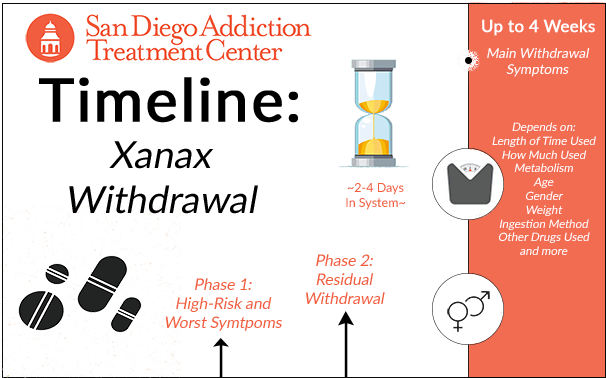Xanax is the brand name for the generic medication alprazolam. Alprazolam is a benzodiazepine, which means that it operates on the brain and central nervous system to produce a calming effect. It is prescribed chiefly for:
- Anxiety disorder and anxious feelings
- Panic disorder and panic attacks
- Depression accompanied by anxiety
- Essential tremor (a tremor disorder of unknown cause, unrelated to Parkinson’s)
- Insomnia

Although it is effective and brings relief to many suffering from anxiety, Xanax is also known to be highly addictive. Serious withdrawal symptoms can occur if the drug is stopped too quickly or without the supervision of a doctor. The prescribing doctor will reduce the dose a little at a time, so that any withdrawal symptoms can be managed and not become disruptive to the patient’s life.
Unfortunately, the addictive quality of Xanax can lead to drug-seeking behavior, especially if addiction has been a struggle in the past. The best way to prevent addiction to Xanax from happening is to take it exactly as it is prescribed and to report any symptoms of either the presenting condition or the Xanax use immediately to a physician.
When Xanax Addiction Occurs
According to Mental Health Daily, Xanax is intended for short-term or occasional use, and it is highly effective when it is used in this way. Problems may arise when Xanax is used for a long time, or when it is used more frequently than the prescribing physician intended.
- Increased tolerance: When it is used consistently and regularly, Xanax users require ever-increasing doses to create the same calming effect.
- Dementia: Xanax can cause dementia in older patients.
- Memory: Xanax makes it difficult to form and retain new memories.
- Drowsiness: Taking Xanax may make it unsafe to drive a car or operate machinery.
- Abuse potential: Xanax has a high potential for abuse and addiction.
Withdrawal Symptoms

If someone is addicted to Xanax, it would be very dangerous to try to quit it all at once or without medical supervision. Xanax doses should be tapered slowly. Even with a controlled tapering process, the individual may experience some withdrawal symptoms.
If the person attempts to quit Xanax cold turkey, severe withdrawal symptoms may occur, and these could potentially be life-threatening.
Xanax withdrawal symptoms may include:
- Headaches
- Blurry vision
- Aching muscles
- Tremors
- Diarrhea
- Numbness in the fingers and other extremities
- Sensitivity to light and sound
- Loss of appetite
- Insomnia
- Heart palpitations
- Sweating
- Anxiety
- Panic
- Paranoia
- Seizures
- Tingling in the arms and legs
- Tension in the jaw
- High blood pressure
It’s Never Too Late to Get Help
A General Timeline for Xanax Withdrawal

Withdrawal usually starts a few hours after the last dose of Xanax. The timeline below follows a four-week process, but most users will experiences symptoms of withdrawal to some degree for much longer than that.
- The first 24-72 hours: During the first 1-3 days, withdrawal is at its worst, and the person is at a higher risk of seizures than at any other time in the process. During this phase, there may also be an increased heart rate, mood swings, insomnia, and nausea and vomiting. This is the most important time for a person to be medically monitored.
- Week 1: Even though the most severe symptoms of the first days have passed, withdrawal is still difficult. Heart rate may continue to race, it may still be very difficult to sleep, and withdrawal symptoms may make the person irritable. Depressive symptoms may begin, and cravings for Xanax become stronger. If the original presenting condition was anxiety, anxiety symptoms may return.
- Week 2: Many of the same emotional symptoms will continue during this week. Depression and irritability are still present, and mood swings may develop. Insomnia is still a problem. More positively, the risk of seizures and other severe reactions has largely passed.
- Weeks 3-4: Sometime during the second two weeks, insomnia will become less of a problem, although sleep may continue to be an issue to some degree for quite some time. Physical symptoms will begin to fade but may still be present, such as headaches and sensitivity. Mental and emotional symptoms may still be present, especially the original anxiety and the need to alleviate it, which led to the Xanax dependency.
At the end of four weeks, the most severe symptoms will have lessened, but they may not go away entirely for several months, even up to a year. They may appear again in some form throughout the person’s life.
Life after Xanax Addiction
To recover from Xanax addiction, the first thing that must be done is address the original presenting disorder, usually a form of crippling anxiety, so that the condition does not cause the person to return to Xanax or find some other way of self-medicating. This is part of the reason why the whole process of withdrawal should be done in consultation with healthcare and addiction treatment professionals.
Even after the most dangerous withdrawal symptoms have passed and the presenting anxiety has been managed, other symptoms may crop up unexpectedly from time to time. Those in recovery from Xanax addiction have reported short-term memory problems due to damage caused by excessive Xanax use, headaches, loss of coordination, muscle aches, and stomach pain. Emotional symptoms that still appeared after going through the withdrawal process sometimes included mild levels of paranoia, occasional depression, irritability, lack of focus, and residual difficulties with damaged relationships.
Withdrawal from Xanax doesn’t follow a strict timeline, and it is difficult to go through, but people in recovery find the process well worth it as they achieve lives of health and balance.
Withdrawal from Xanax Safely
Get Help Now.
Has addiction stolen your loved one? Take action and call (619) 577-4483 or fill out this form to speak with a Treatment Consultant about our drug rehab center or one of our facilities across the United States.
